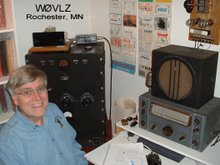 This year I used my Hull Hartley at 10 watts input and a Drake 2B receiver. The change from last year was having a 80 mtr vertical available rather than a simple end fed wire. Unfortunately SE MN was under a blizzard warning for most of the first weekend of the party and I was busy elsewhere for most of the second weekend. Self excited oscillators like the Hull Hartley are prone to frequency wobble whenever the antenna load changes. My vertical swaying in the blizzard wind was too much for it. Rather than wobble all over the band I again used my 105' end fed inverted "L".
This year I used my Hull Hartley at 10 watts input and a Drake 2B receiver. The change from last year was having a 80 mtr vertical available rather than a simple end fed wire. Unfortunately SE MN was under a blizzard warning for most of the first weekend of the party and I was busy elsewhere for most of the second weekend. Self excited oscillators like the Hull Hartley are prone to frequency wobble whenever the antenna load changes. My vertical swaying in the blizzard wind was too much for it. Rather than wobble all over the band I again used my 105' end fed inverted "L".Even with only 3 watts out to a low (10' -15' off the ground) antenna I made 11 contacts and worked both east and west coasts. I had a good time.
Maybe next year I'll have an amplifier for my Hartley so that I can use the vertical (with the sway) and run closer to 6-7 watts out.















